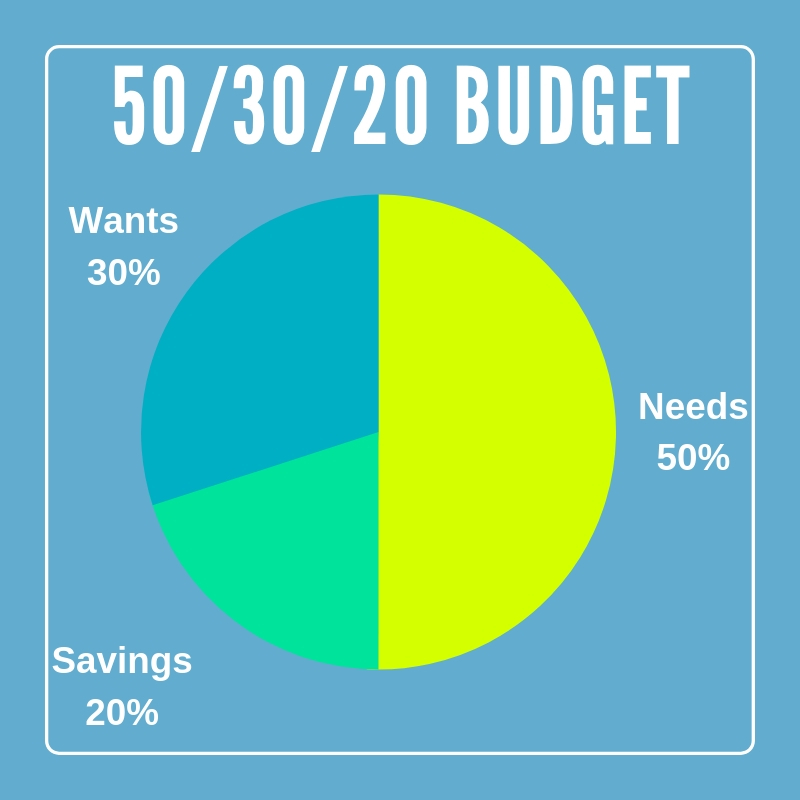
Have you been searching the web for tips on budgeting? You may have come across the 50 30 20 budget or rule (for budgeting).
But, what is the rule and is it right for you?
The 50 30 20 budget or rule is recommendation to spend no more than 50% of your after-tax income (referred to just income for the rest of this post) on necessary expenses (housing, food, etc.), no more than 30% of your income on wants (dining out, shopping), and the remaining 20% to be saved.
Now, that’s the definition of the 50 30 20 budget, but will it work for you?
We know how difficult it can be to create a budget and stick to it.
Sometimes it feels like what’s the point of creating a budget when you fail to hit your spending and saving targets.
But, a budget is more about thinking about your money than actually hitting those goals.
The 50 30 20 budget creates goals but it doesn’t mean that those goals are right for you.
They definitely were not right for us when we lived in San Francisco and rent each month could have bought a used car.
Continue reading and figure out if this budget is right for you.
Details About the Rule/Budget
The 50 30 20 budget was an idea created by Senator Elizabeth Warren and her daughter, Amelia Warren Tyagi in their co-authored book, All Your Worth: The Ultimate Lifetime Money Plan.
Essentially, the goal of it is to limit your spending in the two categories needs (50%) and wants (30%) which results in you saving 20% of your income.

Here are examples of some needs:
- Housing
- Utilities (Electricity, Water, Phone)
- Groceries
- Basic Clothing
- Transportation
- Health Care
Due to housing costs and other high-cost expenses being needs, they take up a bigger portion of your budget.
It can be difficult to lower or change these expenses unless you make some drastic changes.
Here are examples of some wants:
- Cable or Streaming Subscriptions
- Dining Out
- Concerts and Other Entertainment
- Clothing
- Trips and Vacation Travel
Wants are easier to reduce because they are basic needs like shelter, food, and health. But, it can be difficult to change your behaviors like buying a latte every morning.
If you are able to manage your needs and wants to 50% and 30% of your income then you’re left with 20% savings.
Saving 20% of your income is a pretty sweet deal.
But, is this possible for you?
Is the 50 30 20 Budget Possible for You?
A quick way to figure this out is to take all of your transactions for the last month and categorize them as a necessity or a want.
If you need some help doing that, check out our post:
How to Categorize Your Expenses | Understand Your Spending Habits
Then add each category up and divided by your after-tax income.
What are the percentages? Are you below or above for each category?
If your needs make up more than 50% of your income, you may not be able to use this rule for your own budget.

In our case, there have been times when the rule made sense to follow but at other times not so much.
We’ve lived in two different cities (East Coast and West Coast). Though they were both large metropolitan areas, our percentages were different.
In one city we saved roughly 20% of our income and our needs/wants were closer to 55/25%, respectively.
But these allocations changed drastically in the next city we lived in.
The needs ended up being closer to 70% of our income while our savings was closer to 15%.
But, when we did not follow the “rule” we actually saved more money in absolute terms, although it was not 20% of our income.
Basically, we’re saying that this rule might not work in areas where the cost of living is much greater.
So, all other things being equal, is it better to be following the 50/30/20 rule and saving less or not following the rule and saving more?
We think you should be saving as much as possible in dollar terms.
Lower cost of living areas
It is our belief that the 50 30 20 rule is more geared towards people living in lower-cost of living areas (specifically housing).
Housing prices are drastically different throughout the US and while the incomes may also differ, the difference is not always one-for-one.
What if you can’t do the 50 30 20 budget?
For many people living in high-cost of living areas it is difficult to achieve the 50 30 20 budget because rent or mortgage payments are simply too high.
So what do you do if this budget is right for you?
- You could see if you can make changes such as moving
- You could look for a different budget approach
As you can see in our situation, it was actually better to not follow the 50 30 20 budget for our overall savings.
So, what do you do instead?
A Different Budget Approach
Instead of focusing on meeting these percentages, focus on incrementally improving your spending habits.
Create your budget with an understanding of what you’ve spent in the past.
If you need help with this, see our post on simple budgeting.
Once you know how much you’re spending, you can focus on incrementally improving those areas.

At the end of the day, it can be extremely difficult to change how much you spend on “needs” without making some major life changes like moving.
But, you can look for areas where you might be spending more than you expected on your “wants” to reduce expenses and increase savings.
Additionally, keep in mind how much you are actually saving.
We were spending 70% of our income on housing but we were saving more money than we ever had before in our life!
You have to take this into account as well as future earnings potential.
Maybe the job you’re working in right now doesn’t match the 50 30 20 rule but when you get a promotion you’ll be closer to those percentages.
Just make sure you don’t fall in the lifestyle inflation trap when that happens!




Leave a Reply
Your email is safe with us.
You must be logged in to post a comment.